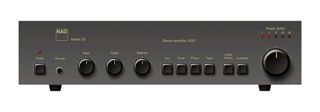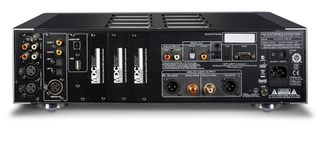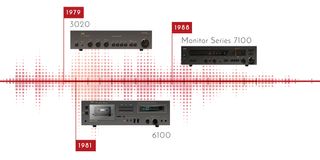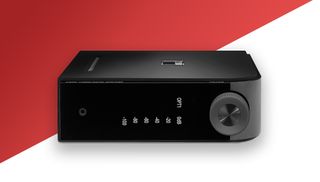Technology moves at a fearsome pace, but some things are timeless. The core goal for any hi-fi component is to get as close as possible to the original performance. It should sonically disappear, so that the music can do its job – making the hairs on your neck stand on end.
When NAD entered the hi-fi arena in 1972, established in London by industry veteran Dr. Martin L. Borish, the electronic giants of the day had lost sight of that goal. They were engaged in a battle of one-upmanship that had seen the development of unnecessary frills wrapped up in impenetrable marketing jargon. This small British firm set out to show them how it should be done.

Seven years later, it all clicked. In 1979, NAD released the 3020, an unassuming-looking integrated amplifier that became the making of the brand.
Where other amplifiers added, the 3020 stripped back. Bjørn Erik Edvardsen, NAD’s director of advanced development, believed that each unnecessary feature adds cost and complexity to the circuits, and creates a potential accuracy-harming obstacle for the audio signal to avoid. By removing them, you straighten the signal path and reduce the chance of it being distorted. The sound remains truer to the original recording.
Although the 3020 was rated at 20 watts, NAD’s version of 20 watts is very different to that of other hi-fi firms. Thanks to its innovative high-voltage, high-current output stage, it could, for a short time, deliver 40 watts into 8ohms, 58 watts into 4ohms and 72 watts into 2ohms – and was thus more than capable of driving the most challenging hi-fi speakers of the day. Rather than settle for the laboratory tests that most used, NAD insisted on testing with real-world speakers – a far more rigorous test of the 3020’s capability.
So while it looked simple, there was plenty going on under the 3020’s hood. It redefined what was possible for an £80 amplifier, wowing the hi-fi press with its warm and articulate delivery and capturing the imagination of the audiophile community. It took on the Japanese giants and won, going on to sell over a million units.
Performance, value, simplicity
The 3020 cemented NAD’s approach to hi-fi. Everything it now creates is guided by three core qualities: performance, value and simplicity. It invests more in the components that make a difference to how its products sound, innovates in ways that genuinely enhance delivery and architects to keep the signal pure, always aiming to put on a knock-out performance at a great price. It’s win-win-win for the discerning hi-fi fan who values audio quality over flashiness, and who wants the most accurate sound achievable at their budget.
Hi-fi for right now

NAD is as committed to class-leading sound quality as it’s ever been, but it recognises that your audio kit now lives alongside and integrates with all sorts of other devices: conventional components, yes, but also TVs, smartphones and your internet connection.
That’s why it builds hi-fi amplifiers with USB ports, TV inputs and Wi-Fi (although those amps can also make the most of a good vinyl pressing), and its why an increasing range of NAD products are managed by its operating system, BluOS.
BluOS is one of the most powerful pieces of technology at NAD’s disposal. It’s the platform that controls a number of NAD’s products, and it sits at the heart of sister brand Bluesound – a range of 24-bit hi-res, high-end wireless multiroom products. Crucially, it lets all these components talk together.

Let’s say you’ve already got an NAD hi-fi with BluOS in your lounge. BluOS lets you add other NAD and Bluesound devices to any room, expanding your hi-fi across your home. It isn’t a collection of barely related devices, either: the shared platform allows devices to work in harmony, with the same core functionality, the same control app, and shared integration with almost every major music streaming service. It’s multi-room audio with system-wide support for hi-res music – and an obsession with sound quality.
What’s more, BluOS is one of the few modern multi-room music platforms that supports standards such as Control4 and Crestron. It means you can put real hi-fi right at the heart of your smart home.
Future-proofed
Modern technology doesn’t mean fast-tracked obsolescence, though. NAD builds kit that can be upgraded to stay ahead of the curve.
Heard of MQA? Think slimmed-down file-sizes but with better-than-CD sound quality and you’re on to what MQA is all about. This is the format that takes studio master quality music and packs it in a file that’s compact enough to be downloaded or streamed, and every NAD device with BluOS can play it, thanks to a recent software update.
What about those itches that software updates alone can’t scratch? That’s where MDC (Modular Design Construction) comes in.
NAD’s MDC-equipped products have modules that can be upgraded to support new hardware standards. This, combined with BluOS, means there’s practically no way you’ll miss out on the next big thing in music tech.
In short, NAD makes real hi-fi for the 21st century: undimmed performance, exceptional value and the right technology to furnish you with the purest music now – and in the future.
NAD's historical highlights

1979: 3020
This is where it began. The 3020 was incredibly simple and incredibly cheap at £80, but it sounded superb and was an enormous success.
1981: 6100
NAD worked the same magic on the cassette deck, creating an extremely capable performer for much less than the competition.
1988: Monitor Series 7100
A rare deviation from NAD’s formula, the 7100 was a beautiful stereo receiver with loads of buttons. Many systems are still in use now.

1993: 302
There have been many descendants of the original 3020 hi-fi amp, with the 302 being one of the most successful.
1998: T 770
The T 770 was a beast of an A/V receiver, and the first with EARS (Enhanced Ambience Recovery System) to make stereo sources sound better through surround speakers.
2007: T 755
Solidly built and maintaining NAD’s obsession with simplicity while embracing Blu-ray, the T 755 was part of the first family to include Modular Design Construction.

2009: M2
A decade-long research project plus three years of development resulted in the M2, an astonishing advanced digital amplifier.
2013: D 7050 Direct Digital Network Amplifier
A seriously stylish network music player and stereo amplifier, the D 7050 was the first NAD product with PerfectPitch – which means it partners particularly well with speakers from sister brand PSB.
2014: VISO HP50
It took over 40 years, but in 2014 NAD finally launched its own headphones. They introduced a new level of accuracy for the price point
2016: MQA
This next-generation file format is set to revolutionise streaming audio quality, and all NAD BluOS devices (such as the M50) can play it
The NAD difference
Think the power rating on an NAD product looks low? All NAD amplifiers, receivers and music systems are made to deliver powerful sound, not specs.
Its designers are concerned with reflecting real-life listening situations – and so they apply stringent measurement standards. They test the amps with a difficult 4-ohm load, with all channels driven simultaneously across the full 20Hz–20kHz frequency range, at rated distortion. That’s a far heftier test than many other manufacturers.
Additionally, NAD’s amplifiers store reserve current that can then be supplied in short bursts, giving extra power to musical crescendos. Known as Power Drive, it gives a boost of musical excitement – and less distortion, even under the most testing circumstances.
The key? Simplicity
NAD doesn’t do things the way other audio companies do. It keeps features to the bare essentials, focusing on honest simplicity.
Simplicity keeps costs down, and every one of those unnecessary features that NAD leaves out means extra investment in the components that really make a difference to performance. Simplicity also improves sound by reducing the electronic clutter within the case and shortening the paths that the audio signals need to travel. There’s less in there to distort the signal, so the sound that gets to your ears is closer to what was recorded at the start of the process. And isn’t that the whole point of hi-fi?
The Hybrid Digital effect

Hybrid Digital is a complex affair. So rather than get bogged down in the details, let’s focus on the results: far more accurate, distortion-free and dynamic sound, without extra cost.
In essence, Hybrid Digital is a high-performance analogue Class-D amplifier (Hypex’s UcD) twinned with an 8-channel DAC. The architecture is simple, reducing signal noise from individual components, and it features a new version of another NAD technology, Power Drive. This keeps current in reserve in order to boost dynamics when needed – so all the detail of the original recording makes the journey to your ears intact.
For more information, visit www.nadelectronics.com